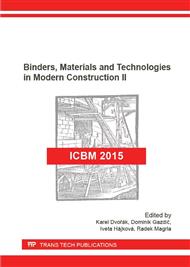p.37
p.42
p.47
p.53
p.57
p.62
p.67
p.72
p.77
Influence of Aluminous Cement on the Hardening Rate of Cement-Based Stucco Mortars
Abstract:
Renovation mortars used to restore damaged stucco elements are materials with special physical properties due to the nature of the work and environment in which they are applied. They must be characterized by low shrinkage, relatively short setting time, appropriate working properties and hydrophobic nature of hardened mortar. This paper analyzes the impact of mortar stucco ingredients on these parameters. The analysis was performed by experimental studies. The effect of the content ratio of aluminate cement to Portland cement on the change in mortar setting time was studied. Suitable workability of fresh mortar is achieved by the use of consistence-modifying additives. To assess this parameter, flow table method was applied in accordance with PN-EN 1015-3: 2000. The additives used were a system of thickeners, which included: cellulose ether in the form of hydroxyethylmethylcellulose and modified starch ether (starch 2-hydroxypropyl ether). Hydrophobic properties were obtained by the addition of triethoxyoctylsilane. The results were presented as graphs and tables. It was found that the ratio of aluminous cement to Portland cement most beneficial in terms of the setting rate of the resulting stucco mortar is 25% (m/m). This amount accelerates the end of setting time to 2 hours, the beginning of the setting time being 20 minutes. Suitable working characteristics were obtained by the addition of 0.080% of hydroxyethylmethylcellulose and 0.025% (m/m in dry mix) of starch 2-hydroxypropyl ether. Best hydrophobic properties of the hardened mortar was obtained by the addition of 0.075% (m/m in dry mix) of triethoxyoctylsilane.
Info:
Periodical:
Pages:
57-61
Citation:
Online since:
August 2016
Authors:
Price:
Сopyright:
© 2016 Trans Tech Publications Ltd. All Rights Reserved
Share:
Citation:


